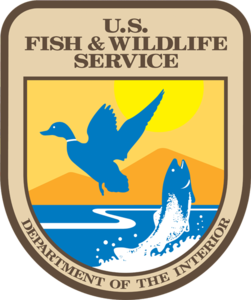Starting as a gated road off Country Road just west of Little Birch Stream, Carter Meadow Road winds back through pine forest passing two private camps before ending at old ranger station with a kiosk and information panel about the refuge and trail.
From here a large, 2-mile loop leads out to an observation platform on the edge of Sunkhaze Meadows where there are fantastic views and opportunities for wildlife watching.
In the winter months, with proper snow conditions, much of the refuge, including the peatland, is accessible by cross-country skiing or snowshoeing.
Sunkhaze National Wildlife Refuge is located in Milford, Maine, just north of Bangor. Established in 1988 and more than 10,000 acres in size, it surrounds nearly five miles of Sunkhaze Stream and another 12 Miles of its tributaries. The U.S. Fish and Wildlife Service manages the refuge to protect important habitats for wildlife, including forested, uplands, alder/willow riparian zones, cedar swamps, and the large peatland complex for which it is named. The peatland is one of the largest in Maine, along with Caribou Bog, Crystal Bog, and Great Heath. It contains several raised dome bogs with peat deposits up to 15 feet deep. Migratory waterfowl and wading birds such as black ducks, wood ducks, great blue herons, and American bitterns use the stream habitat. American woodcock benefit from the diversity of habitats on the refuge. Neotropical migratory bird species, including chestnut-sided warblers, scarlet tanagers, and olive-sided flycatchers nest in the forested uplands. Resident wildlife includes ruffed grouse, red-tailed hawks, beavers, white-tailed deer, moose, black bears, coyotes, and river otters.
Sunkhaze Meadows National Wildlife Refuge is managed as part of the Maine Coastal Islands National Wildlife Refuges with help from the Friends of Sunkhaze Meadows National Wildlife Refuge. Their mission is to “preserve the peatland ecosystem and maintain a biologically diverse area for native wildlife and plants, while offering opportunities for wildlife- and wildland-oriented activities.” In keeping with this purpose, the refuge is open to visitors year-round during daylight hours and offers recreational opportunities that are compatible with its wildlife and habitat management objectives.
Observe wildlife from a safe and respectful distance. Hunting is permitted on the refuge, with most activity occurring during October and November. Blaze orange is required for hunters and strongly recommended for hikers. During the summer months, biting flies and mosquitoes are abundant. Insect repellent is highly recommend. Dress appropriately for your activity and have foul weather gear with you. Waterproof footwear is recommended.
Please restrain all pets on leashes. Loose dogs may harass wildlife and detract from other visitors’ enjoyment of the refuge.
 Natural Heritage Hikes is a project of the Maine Natural Areas Program in partnership with Maine Trail Finder. View the "Sunkhaze Meadows National Wildlife Refuge - Carter Meadow Road" guide online here.
Natural Heritage Hikes is a project of the Maine Natural Areas Program in partnership with Maine Trail Finder. View the "Sunkhaze Meadows National Wildlife Refuge - Carter Meadow Road" guide online here.
Visit Sunkhaze Meadows National Wildlife Refuge, Maine Coastal Islands National Wildlife Refuges, and Friends of Sunkhaze Meadows National Wildlife Refuge online for more information or contact:
Friends of Sunkhaze Meadows National Wildlife Refuge
The refuge may be reached one of two ways. To reach the southern half of the refuge, including Johsnon Brook Trail, take County Roud off US Route 2 in the center of Milford. To reach the northern half of the refuge, including Sunkhaze Stream and the Ash Landing Trail, follow US Route 2 north to Costigan, and turn right onto Greenfield Road. Take your first right (at Parkeway Transportation and Northland Service signs) onto Stud Mill Road. Follow the road as it turns left in about 0.5 miles and then continues east to the refuge. It is approximately two miles from this turn to the refuge boundary. (Note: Do not park along Stud Mill Road; this private road is used by heavily loaded logging trucks which have the right of way.)
Carter Meadows Road is a signed, gated road off County Road 6.4 miles from US Route 2. The parking area, which includes an informational kiosk, is a little further on the left.
Success! A new password has been emailed to you.
Much like the Johnson Brook, Carter Meadow Road seems to see seldom usage. The walk begins on a wide road before reaching a closed FWS cabin. I started the loop on its right side: compared to the left side of the loop, this portion likely gets little use. The trail narrows considerably and as of 8/11/21 was extremely muddy in several patches. The left side of the loop is far easier to navigate, as its less narrow and was dry pretty much the entirety of the way. Unfortunately, several portions of the boardwalk on this side of the loop were beginning to rot or collapse.
Trails could stand to be marked on the right side of the loop, as some areas are beginning to experience overgrowth. The left side of the trail slightly marked with little FWS placards on the trees, but the overgrowth on this portion of the loop isn't as evident as the right side, so it's easier to follow the trail. The observation deck is also pretty weathered and wobbly: I wouldn't recommend anymore than one person at a time on here currently. Regardless, it's a nice view of the bog and a surprisingly nice escape from the bugs, which aren't too much of an annoyance on the deck compared to the woods.
While the Carter Meadow Road Trail isn't particularly scenic in contrast to other trails in the area, it still presents itself as a great, relatively short venture into the wild. If you can stand the insects and the "rough country" found on the right side of the loop, Carter Meadow presents itself as an excellent opportunity for hikers looking for a diverse environment.